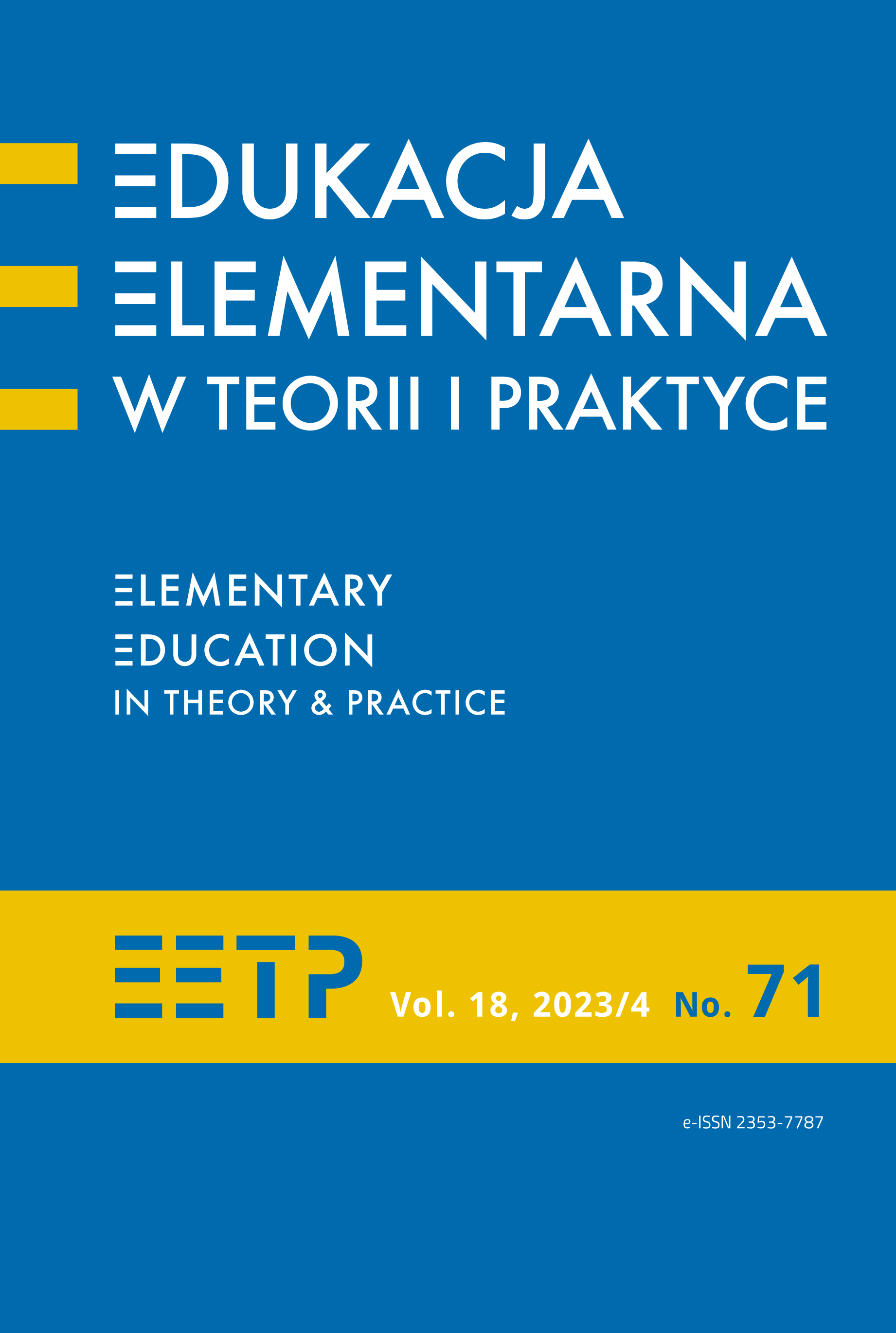Kreacje bohaterów w komiksie edukacyjnym dla dzieci a identyfikacja i przekaz wiedzy
Abstrakt
Komiks edukacyjny jest popularnym gatunkiem artystycznym w kulturze dziecięcej, jego siła przekazu i oddziaływania tkwi w korelacji między warstwą werbalną i wizualną (ikonotekstowość). Jednakże nie tylko obraz i tekst mają decydujący wpływ na odbiór wspomnianego medium. Elementem kluczowym dla każdego komiksu jest bowiem postać bohatera (zob. Toeplitz, 1985), która w połączeniu z cartoonowością wpływa na ułatwienie identyfikacji młodym czytelnikom. Celem niniejszego artykułu jest zbadanie relacji pomiędzy postacią bohatera a przekazem wiedzy i utożsamieniem się z protagonistami. Klasyfikacja, która została przyjęta w rozważaniach, polega na wyróżnieniu czterech typów bohaterów obecnych w komiksach edukacyjnych dla młodych odbiorców: dziecięcego, dorosłego, zwierzęcego i fantastycznego. Analiza wykazała, że protagoniści są konstruowani w taki sposób, aby zmniejszyć dystans pomiędzy czytelnikiem a książką, a tym samym ułatwić młodemu odbiorcy identyfikowanie się z bohaterami. Kreacje postaci w znaczący sposób wpływają na proces lektury i emocje czytelnika, a tym samym dają możliwość poruszania różnych tematów i przekazywania skomplikowanych treści.
Bibliografia
Birek, W. (2014). Z teorii i praktyki komiksu. Centrala Mądre Komiksy.
Flood, J. (2019). Rekiny. Najlepsi myśliwi w przyrodzie. Nasza Księgarnia.
Gałczyńska, A. (2008). Słownictwo tekstów kierowanych do dzieci – zdrobnienia i spieszczenia. Annales Academiae Paedagogicae Cracoviensis. Studia Linguistica, 4, 76–83.
Hallberg, K. (2017). Literaturoznawstwo a badania nad książką obrazkową (H. Dymel-Trzebiatowska, tłum.). W: M. Cackowska, H. Dymel-Trzebiatowska i J. Szyłak (red.), Książka obrazkowa. Wprowadzenie (s. 49–56). Instytut Kultury Popularnej.
Karska, E. i Kiełbus, S. (2010). Między dniem a snem w Wilanowie. Część pierwsza. MAAR Marzena J. Bachan.
Kurasiński, A., Kucharska, N., Kulesza, R., Langa, S., Leśniakiewicz, D. i Pełka, P. (2019). Róża, a co chcesz wiedzieć́? Komiks edukacyjny o technologiach dla dzieci. Helion.
McCloud, S. (2015). Zrozumieć komiks (M. Błażejczyk, tłum.). Kultura Gniewu.
Michułka, D. i Gregorowicz, Ł. (2018). Czytanie pamięci – doświadczenie – emocje. Narracje literackie dla młodego czytelnika – teoria i praktyka odbioru (Rutka Joanny Fabickiej). Polonistyka. Innowacje, 7, 41–58. https://doi.org/10.14746/pi.2018.7.4
Redyk, M. (2008). Edukacyjna wartość pytań dzieci w wieku wczesnoszkolnym. Forum Dy-daktyczne: Przeszłość, Teraźniejszość, Przyszłość, 3/4, 84–98.
Reed, M. i Flood, J. (2018). Dinozaury. Skamieliny i pióra. Nasza Księgarnia.
Rzecznik, M. i Nowacki, P. (2017). Reformator. Widnokrąg.
Samojlik, T. (2017). Ryjówka przeznaczenia. Kultura Gniewu.
Samojlik, T. (2019). Na ratunek mateczce Ziemi. Związek Gmin Regionu Puszczy Białowieskiej.
Szyłak, J. (2000). Poetyka komiksu. Warstwa ikoniczna i językowa. Słowo/Obraz Terytoria.
Szyłak, J. (2013). Komiks w szponach miernoty. Timof i Cisi Wspólnicy.
Tałuć, K. (2017). Komiks polski dla młodego odbiorcy – tendencje, tematy, wydawcy. W: K. Tałuć (red.), Literatura dla dzieci i młodzieży, t. 5. (s. 254–286). Wydawnictwo Uniwersytetu Śląskiego.
Toeplitz, K.T. (1985). Sztuka komiksu. Próba definicji nowego gatunku artystycznego. Czytelnik.
Zasacka, Z. (2014). Czytelnictwo dzieci i młodzieży. Instytut Badań Edukacyjnych.
Zasacka, Z. (2015). Antynomie szkolnych i pozaszkolnych lektur. Polonistyka. Innowacje, 2, 35–50. https://doi.org/10.14746/pi.2015.1.2.3
Copyright (c) 2023 Edukacja Elementarna w Teorii i Praktyce

Utwór dostępny jest na licencji Creative Commons Uznanie autorstwa – Bez utworów zależnych 4.0 Międzynarodowe.
1. Autor zgłaszając swój artykuł oświadcza, że jest Autorem artykułu (zwanego dalej Utworem) i:
- przysługują mu wyłączne i nieograniczone prawa autorskie do Utworu,
- jest uprawniony/a do rozporządzania prawami autorskimi do Utworu.
Oświadcza, że nie narusza praw autorskich osób trzecich i praw prawnych.
Oświadcza, że nie występuje żaden konflikt interesów.
2. Udziela Uniwersytetowi Ignatianum w Krakowie nieodpłatnej, niewyłącznej, nieograniczonej terytorialnie licencji do korzystania z Utworu na następujących polach eksploatacji:
- utrwalania utworu w formie papierowej, a także na nośniku cyfrowym lub magnetycznym;
- zwielokrotnienia utworu dowolną techniką, bez ograniczenia ilości wydań i liczby egzemplarzy;
- rozpowszechniania utworu i jego zwielokrotnionych egzemplarzy na jakimkolwiek nośniku, w tym wprowadzenia do obrotu, sprzedaży, użyczenia, najmu;
- wprowadzenia utworu do pamięci komputera;
- rozpowszechniania utworu w sieciach informatycznych, w tym w sieci Internet;
- publicznego wykonania, wystawienia, wyświetlenia, odtworzenia oraz nadawania i reemitowania, a także publicznego udostępniania utworu w taki sposób, aby każdy mógł mieć do niego dostęp w miejscu i czasie przez siebie wybranym;
- w zakresie praw zależnych do Utworu, obejmujących w szczególności prawo do dokonania koniecznych zmian w Utworze, wynikających z opracowania redakcyjnego i metodycznego, a także do dokonania tłumaczenia Utworu na języki obce.
Udzielenie licencji następuje z chwilą przekazania Utworu na rzecz Uniwersytetowi Ignatianum w Krakowie. Uniwersytet Ignatianum w Krakowie jest uprawniony do udzielania dalszych sublicencji do Utworu, w zakresie udzielonego prawa. Licencja jest ograniczona czasowo i zostaje udzielona na okres 15 lat, licząc od daty jej udzielenia.
Wyraża się zgodę i zachęca autorów do publikacji ich tekstu w Internecie (np. w repozytorium instytucji lub na jej stronie internetowej) przed lub podczas procesu składania tekstu jako, że może to prowadzić do korzystnych wymian oraz wcześniejszego i większego cytowania opublikowanego tekstu (Patrz The Effect of Open Access). Zalecamy wykorzystanie dowolnego portalu stowarzyszeń badawczych z niżej wymienionych:




